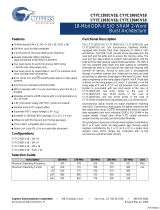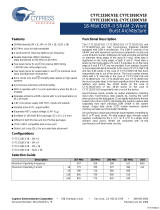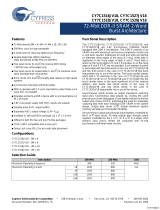Page is loading ...

Marshall
Electronics
VS‐TKC‐100
PTZ
Controller
UserManual

Page 2 of 28
Copyright © May 2012, Marshall Electronics, Inc.
All Rights Reserved. This document may not be copied.
Trademarks
Other trademarks used in this document are registered trademarks or manufacturer or vendor
trademarks associated with the products.
Disclaimer
Product options and specifications can be changed without notice. The information in this
manual is furnished for informational use only and should not be construed as a commitment
by Marshall Electronics, Inc.. Marshall Electronics, Inc. assumes no responsibility or liability for
any errors or inaccuracies that may appear in this publication.

TABLE OF CONTENTS
Page 3 of 28
1. Introduction................................................................................. 4
2. Installation Process............................................................................. 7
3. Installing the Marshall Video Management Software.............................. 8
4. Wire the PTZ Camera(s)............................................................................. 10
5. Set Up VMS for Soft On-Screen PTZ Control…...................................... 11
6. Connecting TKC-100 and Installing the Driver......................................... 18
7. Verifying the COM Port TKC-100............................................................... 22
8. Set Up the Seriel Protocol in VMS…………………………………............. 23
9. Set Up “PTZ SETUP” on the TKC-100……..……………………............. 25
10. Test TKC-100 with VMS Software ………………………………............. 26

1. Introduction
Page 4 of 28
About the VS-TKC-100
The Marshall PTZ Controller, VS-TKC-100 is designed
as a Hardware Pan, Tilt, Zoom and
Focus Controller to work with Marshall Cameras under Marshall Video Management
Software Control.
It operates under either Battery Power (9V) or AC with the included Marshall AC Adapter (12V).

1. Introduction
The VS-TKC-100 is designed to connect to the Computer that hosts the Marshall
Video Management Software by USB, both V1.1 and V2.0 are supported.
The Marshall Video Management Software is available in a number of versions the only
difference between them being how many Cameras can be controlled and viewed at the same
time at the Console.
VMS-16 Supports 16 Camera on Screen at one time
VMS-32 Supports 32 Camera on Screen at one time
VMS-64 Supports 64 Camera on Screen at one time
VMS-128 Supports 128 Camera on Screen at one time
The VMS Software is used to select which Camera is controlled by the VS-TKC-100.
The VMS Software offers not only the ability to Monitor the Cameras but also to Record them
either by schedule, event or manually. We use a proprietary recording format, which allows
us to record all the Streams to one File together with an individual audio track per camera.
There is a stand-alone viewer available (VMS Client) without any control features to View an
Audio/Video Live Stream or playback a Recording on another Computer.
The VS-
TKC-100 is designed to work exclusively with the Marshall Video Management
Software and does not work with the Live View in Internet Explorer. So even if you are using
just one Camera you must have the VMS Software Installed.
The choice of the Host Computer and its performance is determined by two factors, the
resolution of the Cameras being displayed and how many will displayed at the same time. An
installation with 4 Cameras at 720P will need less Computer horsepower than 16 Camera at
1080P.
Page 5 of 28

1. Introduction
Page 6 of 28
We will describe the basic features of the Marshall Video Management Software VMS-16, as it
is an intrinsic part of using the TKC-100, however, to enjoy all the advanced features of
the VMS Software we encourage you to read the VMS User Guide.
So this manual will go over an Installation that has one Marshall PTZ Camera, a Computer and
a Marshall VS-TKC-100 PTZ Controller. If the Installation had a number of PTZ Cameras
and / or Fixed Cameras you only need to add an IP Switch between the Cameras and
Computer to accommodate this.
RJ45
USB

2. Installation Process
Page 7 of 28
The Installation process is broken down into a number of steps. You may of course omit any
of these steps if they have already been done:
2-1 Install the Marshall Video Management Software – VMS-16.
2-2 Wire a Marshall PTZ Camera with a RJ45 Cable to the Host Computer.
2-3 Set-up the Camera to work with the Software using the Soft On-Screen PTZ Control.
2-4 Connect the Marshall VS-TKC-100 PTZ Controller with the supplied USB Cable to
the Computer and Install the FTDI CDM Drivers.
2-5 Check what COM Port the TKC-100 has been assigned.
2-6 Set-up the Serial Protocol within the Marshall Video Management Software to match
the VS-TKC-100 chosen settings.
2-7 Set-up the “PTZ Setup” on the TKC-100.
2-8 Test the TKC-100 for Pan, Tilt, Zoom and Focus.
To do this installation you will need the following:
- Marshall Video Management Software – VMS-16
- Marshall TKC-100 FIDI Driver
- Marshall PTZ Camera
- Windows Computer XP Professional SP2 or above
- Marshall TKC-100 PTZ Controller with USB Cable
- RJ45 Cable
Once the Installation and test are complete it is very easy to add or subtract cameras in the
future.

3. Installing the Marshall Video Management Software
Page 8 of 28
The Marshall Video Management Software is installed on a Windows Computer, which meets
the following minimum specifications:
Windows XP Professional SP2 or above, Vista Business, Server 2003, Server 2008 or
Windows 7 Professional.
CPU Intel Pentium 4, 2.4GHz or higher.
RAM: 1GB or larger.
Network: Ethernet 100Mbps or higher.
Graphics:
- Graphics memory: 128MB or larger
- Dir
ectX9.0c installe
d
- Screen reso
lution: 1024x768 or larg
er
The Marshall Video Management Software is available in two versions:
- VMS Server Software – known as VMS Software
- VMS Client Software
To use the TKC-100 you will need to install the VMS Software.
3-1 Find the file folder on the TKC-100 Installation Disk called: “VMS Software”.
3-2 Double left click on the file “VMS1_06_5111.exe”.
3-3 The Welcome to the InstallShield Wizard for VMS window will appear, Click “Next”.
3-4 When localization window appears, select language of your choice, Click “Next”.
3-5 Choose destination location; typically use the default setting “C\Program
Files\VMS\”. Click “Next”.
Note: The above minimum requirements are for normal use with a few cameras. The requirements
to support more cameras vary a lot depending on the number of channels, video resolution,
framerate, bitrate etc. Please contact Marshall Technical Support to get the recommendation for a
specific configuration for supporting a large number of cameras.

3 – Installing the Marshall Video Management Software
Page 9 of 28
3-6 After the install program pane appears, Click “Install” and the install will begin
automatically.
3-7 When the installation is complete, a window will appear stating “Installation
Complete”. Do not select “Launch VMS” box as shown below. Click “Finish”.
3-8 You should find an icon on the desktop that looks like this:

4. Wire the PTZ Camera(s)
Page 10 of 28
4-1 Connect up one or more Marshall PTZ Cameras to the Host Computer with
Cat5e/RJ45 Cable. If you have one Camera you may direct connect it to the Host
Computer. For more than one PTZ Camera you will need to insert a Switch between
the Cameras and the Host Computer as shown below.
Cat5e/RJ45
Cat5e/RJ45
Cat5e/RJ45
Network Switch
Host Computer with VMS

5. Set Up VMS for Soft On-Screen PTZ Control
Page 11 of 28
The first thing to do is set-up the Host Computer for a Fixed IP Address.
Here’s an example using Windows XP Professional:
5-1 Go to Control Panel and open Network Connections.
5-2 When you connect the Switch or Camera, you’re computer find the acquired the
device. The computer in this example has a Dual NIC (
Network Interface Card) so it
can support both a Static and DHCP Network at the same time.
5-3 Right mouse click the Local Area Network Connection, highlight the Internet Protocol
(TCP/IP) and click on Properties.
5-4 The Internet Protocol Properties Page will appear to set up for DHCP.
5-5 Select “Use the following IP address”.

5. Set Up VMS for Soft On-Screen PTZ Control
Page 12 of 28
5-6 Enter IP Address 192.168.1.99 and the subnet mask will populate automatically.
Click OK, and OK again to close.
5-7 Make sure your PTZ Camera(s) are powered on and connected.
5-8 Launch the VMS Software by double left clicking the VMS Icon on the desktop.
5-9 You will see the Video Management System Login Screen as shown below.
The Default Login Credentials ar
e:
User ID: admin
Password: 1234
If you choose to check the box Automatic Login you will not be asked for a password
on launch, but you will need the password to exit VMS.

5. Set-up VMS for Soft On-Screen PTZ Control
Page 13 of 28
5-10 The VMS Home Page appears with a superimposed notice over it “VMS recording
failure”. The VMS Application as well as monitoring “Live Streams” from up to 16
sources with audio (VMS-16 Version) can also record them in a Muxed File (also
known as Multiplexing) and can play them back in a multi-viewer presentation. The
notice means that no hard drive has been allocated to record the streams. We don’t
need this feature to set-up and test our PTZ Controller so we will simple click “OK”
and close the notice. If interested in using the Record Feature, set up details can be
found in the VMS Manual.
5-11 Click ”Setup” on the menu at the top left of the screen and click “Camera”.
5-12 On the Setup Screen, just below the table of cameras which is currently
unpopulated, click on the button marked “Discovery”.
5-13 Another window will open with camera(s) IP, Mac Address, Base Port, HTTP Port
and IP Address. New cameras will default to the factory IP address
of
“192.168.10.100”. Because of this common IP address, all new cameras should be
connected one at a time to change IP address to a unique address.

5. Set-Up VMS for Soft On-Screen PTZ Control
Page 14 of 28
5-14 First select the Camera or Encoder you wish to change by highlighting in the table.
Next click “IP Change” and change to a unique IP address.
Example: Change the IP Address to 192.168.1.150 and change the Gateway to
192.168.1.1. To complete, click “Change”.

5. Set-Up VMS for Soft On-Screen PTZ Control
Page 15 of 28
5-15 Now back at the “Setup” page, click “Discovery” again, highlight the Camera or
Encoder and click “Select”.
5-16 Now the “Add Camera” window appears. Fill in the following fields; see example
with answers in italics. Many fields will auto populate. When finished, click “OK”.
Name: Main Gate
Group: 1
Type: IP Camera Name
Address: Fills in Automatically
Login: admin (Default)
Password: 1234 (Default)
Channel: 1
Port: 2222
Additional Information: Both “Use PTZ” and “Use audio channel” should be checked.

5. Set-Up VMS for Soft On-Screen PTZ Control
Page 16 of 28
5-17 Now you should be back at the Setup Window and your camera should be in the list.
Click “OK”.
5-18 On the Home Page of the VMS Application, the “Main Gate” Camera will auto
populate on the Control Pane.

5. Set-Up VMS for Soft On-Screen PTZ Control
Page 17 of 28
5-19 Using the mouse, hold the left button and drag the Main Gate Camera from the
control pane to one of the video windows in the multi-viewer. You will see a number
of options at the bottom left: “Storage”, “PTZ”, “Audio” and “Video”. Select “PTZ”.
5-20 The Soft PTZ Control allows for Pan and Tilt together with Zoom and Focus. You
should have control of the camera now. Dragging the small button inside the
circular plate moves the camera to the desired location and the distance from the
center sets the speed. Zoom and focus are triggered by pressing (-) or (+) button.
Focus provides auto-focus functionality by the button with car sign inside.
The speed of zoom and focus operation is controlled by setting the Speed slider.
We will now connect the VS-TKC-100, PTZ Hardware Controller and Install the
Serial Control Drivers. You should close all programs including the VMS Software
when doing this.
Drag the button

6 – Connecting TKC-100 and Installing the Drivers
Page 18 of 28
6-1 Disconnect the
Host Computer from the Internet.
6-2 Copy the TKC-100 folder and contents to your system hard drive, typically “C”.
6-3 Connect the AC Adapter to the VS-TKC-100 Make sure it’s switched off. If not, press
the red “ESC/PWR” button with no data on the display. Connect the supplied USB
cable to the TKC-100 and the other end to a free USB port on the host computer.
6-4 Switch on the TKC-100.
6-5 “Found New Hardware” Balloon appears on the task bar.
6-6 The “Found New Hardware Wizard Opens” to install the “FT232R USB UART”.
USB

6. Connecting TKC-100 and Installing the Drivers
Page 19 of 28
6-7 Select “Install from a list or specific location (Advanced)”.
6-8 Check the boxes as shown and browse to the TKC-100 drivers folder that was put
on the “C” drive earlier.

6. Connecting TKC-100 and Installing the Drivers
Page 20 of 28
6-9 The “Completing the Found New Hardware Wizard” Window appears. Click “Finish”.
6-10 Now the “Found New Hardware Wizard Opens” to Install the “USB Serial Port”.
6-11 As before, select “Install from a list or specific location (Advanced).”
/




